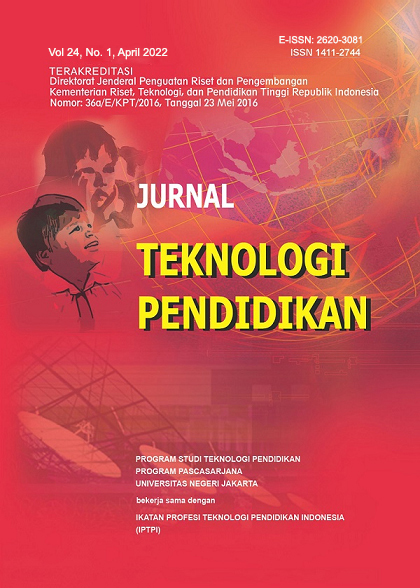Development of Web Programming Interactive Learning Multimedia in Vocational Middle School
DOI:
https://doi.org/10.21009/jtp.v24i1.24242Keywords:
Development Research, Teacher, Research, Interactive Learning MultimediaAbstract
The research aimed to develop interactive multimedia learning on web programming materials in Vocational High schools. This research was conducted at SMK Negeri 1 Sajingan Besar, with the research subjects were students in class XI of Software Engineering expertise competency as many as 48 students. The research method used is a 4D model consisting of four stages, namely define stage, design, develop, and disseminate. Interactive learning multimedia developed validated by three media experts with an average result of 3.9 with a category of "valid," 3 material experts with an average result of 4.09 with a category of "very valid" and three design experts with an average score of 4.32 with a category of "very valid." Developer trials with an average value of 82.9% with "positive" criteria. Multimedia has an initial view that contains several menus, namely material, SK-KD, Quiz, Help, About, and Download. The effectiveness of the use of interactive learning multimedia is done by looking at the responses of students and learning outcomes. The response result of 48 students was with an average score of 81.91% with the criteria "positive." The average student learning outcome for pre-test was 37.33 and for post-test was 59.97, with a difference of 22.64. Based on the results of the T-test that the sig value (2-tailed) is 0.000 < 0.05 and the t value counts > t table, (23,778) > (2.35), These results show there is a significant difference between before and after using interactive learning multimedia on web programming materials. As for the effect size test was conducted to find out the level of effectiveness in the use of interactive learning multimedia with a value of 2.83 with the category "Strong Effect."
References
Basri, M., Husain, B., & Modayama, W. (2020). University Students’ Perceptions in Implementing Asynchronous Learning During Covid-19 Era. Metathesis: Journal of English Language Literature and TeachingVol. 4, No. 3, 263-276.
Cairncross, S., & Mannion, M. (2001). Interactive Multimedia and Learning: Realizing the Benefits. Innovations in Education and Teaching International, 156-164.
Mering, A. (2020). Pengembangan Instrumen Penilaian dan Penelitian. Pontianak: IAIN Pontianak Press.
Mills, G. E., & Gay, L. R. (2019). Education Research Competencies for Analysis and Applications Twelfth Edition. America: Pearson Education, Inc.
Munir. (2012). Multimedia Konsep & Aplikasi dalam Pendidikan. Bandung: Alfabeta, CV.
Priyanto, D. (2009). Pengembangan Multimedia Pembelajaran Berbasis Komputer. INSANIA Vol. 14 , 1-13.
Putri, V. R. (2018). Teachers in the Digital Age. 3 rd International Conference on Education 2018 (pp. 12-13). Batusangkar: IAIN Batusangkar.
Santhalia, P. W., & Sampebatu, E. C. (2020). Pengembangan multimedia interaktif fisika untuk meningkatkan pemahaman konsep fisika siswa pada era pendemi Covid-19. Jurnal Inovasi Pendidikan IPA, 6 (2), 165-175.
Uno, B,.H & Ma'ruf, K,.R. (2016). Pengembangan Media Pembelajaran IPS Berbasis Website untuk Peserta didik Kelas VII Madrasah Tsanawiyah Negeri. Jurnal Teknologi Pendidikan. 18(3): 169-185.https://doi.org/10.21009/jtp.v18i3.5372
Vaugan, T. (2011) Multimedia: making it work. Eighth Edition. New York: Technology Education Mac Graw Hill.
Yaumi, M. (2013). Prinsip-Prinsip Desain Pembelajaran. Jakarta: Kencana.
Downloads
Published
How to Cite
Issue
Section
License
Jurnal Teknologi Pendidikan is an Open Access Journal. The authors who publish the manuscript in Jurnal Teknologi Pendidikan agree to the following terms.
Attribution-ShareAlike 4.0 International (CC BY-SA 4.0)
-
Attribution — You must give appropriate credit, provide a link to the license, and indicate if changes were made. You may do so in any reasonable manner, but not in any way that suggests the licensor endorses you or your use.
-
ShareAlike — If you remix, transform, or build upon the material, you must distribute your contributions under the same license as the original.
- No additional restrictions — You may not apply legal terms or technological measures that legally restrict others from doing anything the license permits.
Notices:
- You do not have to comply with the license for elements of the material in the public domain or where your use is permitted by an applicable exception or limitation.
- No warranties are given. The license may not give you all of the permissions necessary for your intended use. For example, other rights such as publicity, privacy, or moral rights may limit how you use the material.








